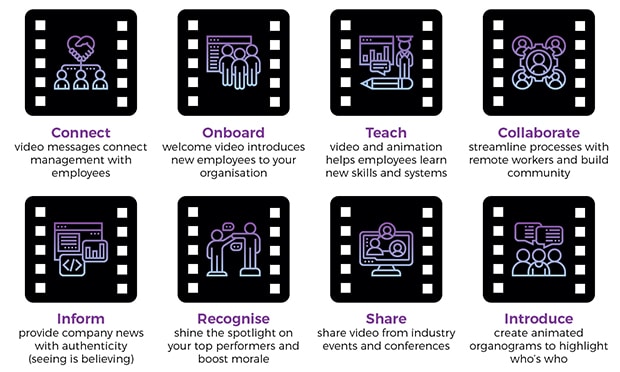Why visuals are important in your internal communications

The human brain is genetically hardwired to process information in images, be it static or moving. Now consider that about 78% of people watch videos online every week and this year 80% of all internet traffic will be video – so it makes sense that visuals are the key to landing your internal communications messages.
In a business environment where inboxes are bursting at the seams and time is money, taking a visual approach to your internal communications makes sense. A study by the Massachusetts Institute of Technology found it takes the brain just 13 milliseconds to process an image.
Here are five reasons why visuals will help you land your message to employees quickly and effectively.
1. Saves time
It’s far quicker and easier for the brain to process an image, which can communicate a lot of information in a short space of time – 90% of all information sent to our brains and 93% of our communication is visual. It would take you one second to read a written warning sign on the side of the road, but your brain could easily assimilate and interpret that information visually in less than a quarter of a second.
2. Clear and consistent message
The use of simple graphics, colours and logos as well as videos keep your message clear and consistent across organisations, cultures, geography and literacy levels. Written words might not be understood in the same way by everyone but in the business environment it’s important that all employees interpret your communications in the same way.
3. Better retention
A number of studies have shown that visual information is remembered better and for longer than the written word as visuals are stored in long-term memory while written words are stored in short-term term memory. According to the Visual Teaching Alliance, people can remember the content of 2 500 pictures with over 90% accuracy 72 hours after looking at them for only 10 seconds. With traditional lecture format delivery, students only remember 10 percent of the material 72 hours later.
4. It’s the new normal
Your employees are used to a rich visual experience in their online activity, from images to videos and GIFs, and they’ve come to expect the same of their internal communications. Two years ago, Giphy was already delivering 1 billion GIFs a day and Google Lens allows you to upload an image for searching instead of typing in words into a search box.
5. Cuts through the clutter
Visuals offer a richer experience than the written word and with a vast array of content competing for attention in cluttered inboxes, readers quickly scan information rather than reading the whole message. Visuals are a proven way to get more information across in less time with a better retention rate – and they evoke an emotional response, landing your message more effectively.
With video being the most popular form of communicating (and expected to remain so for the next 5-10 years), remember to Lead from in front of the camera.
Here are a few ways you can include video in your communication, saving you time and landing your message more effectively:

Our award-winning team of designers and editors are skilled visual storytellers – chat to us about how we can help bring your internal communications to life.

